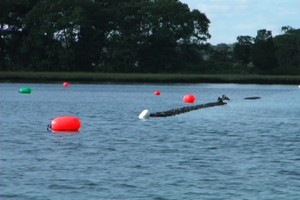 Point Judith Pond is one of Rhode Island’s jewels, a four-mile stretch of crystal-clear water bordering Narragansett and South Kingstown. Tucked up in the northeastern side is Champlin Cove, adjacent to a housing development called Briggs Farm.
Point Judith Pond is one of Rhode Island’s jewels, a four-mile stretch of crystal-clear water bordering Narragansett and South Kingstown. Tucked up in the northeastern side is Champlin Cove, adjacent to a housing development called Briggs Farm.
Jeff Maul has lived in Briggs Farm for the past decade and is often out on the water in his 18-foot powerboat, enjoying the beauty of the cove. “A good number of people in this development have boats right here. They go fishing, they go boating, they pull tubes, water-skiing, clamming, diving — you name it, they do it.’’
Over the years Maul has seen an increasing number of buoys in the water marking oyster farms approved by the state of Rhode Island. They vary in size, from just an acre or two up to 20 acres. It is land leased by the state and off limits to boaters and other shell fishermen.
“Two or three years ago another one appeared over here, just across from us at Ram Island,” Maul said. “The following year that one doubled in size. Another one appeared on the other side of Ram Island. This past year there’s probably been a half dozen or more permits, and we’ve seen these buoys pop up everywhere. They basically rope off an area and it’s no longer public.”
Maul says he has no issue with aquaculture itself, the official name for oyster farming, which has grown into a $4 million annual industry in Rhode Island with nearly all of it coming from the 52 oyster farms spread across the state’s waters. It’s the placement of one recent proposal that he and his neighbors oppose.
“It’s right across from our marina; it’s in an area where people do a lot of tubing and water skiing,” he said. “It’s in the expansion of the end of the cove and that’s generally where people do a nice wide sweep with their boat. The (oyster) farm we’re concerned with hasn’t been authorized yet, but they’ve staked it out. The buoys are showing that this thing is protruding a third of the way into the cove.”
That application from Narragansett resident David Bartley resulted in dozens of homeowners in Briggs Farm writing to the Coastal Resources Management Council, which is responsible for approval or rejection of oyster farm licenses.
David Beutel is CRMC’s aquaculture coordinator and will decide whether to recommend approval of Bartley’s application to the full council. The plan originally called for a 2.9 acre oyster farm just east of Ram Island in Champlin Cove.
“Mr. Bartley has been debating on how to go forward and they decided to address some of the objections by making the proposed area smaller, more narrow, to give a little more room in the theoretical channel,” Beutel said.
The revised proposal reduces the size by an acre, but Maul says does not fully address concerns about conflicting uses on the water. And that is the sometimes delicate balance between the state and the people who live near and use Rhode Island’s waterways — particularly the coastal ponds.
Jim Hummel: What was your feeling and your observation in terms of boat traffic, water skiing or tubing, and trying to get in and out of there?
David Beutel: My initial review of it was that there’s sufficient room for both. I do acknowledge and understand that if somebody strayed and there were cages in that area that would be a problem if they fell. I’m happy to see that Mr. Bartley wanted to make it narrower into the shallow part of the proposed area.
Maul says it poses a real problem for boaters. “These will be wire cages that might be a few inches below the surface of the water or they might even be partially exposed at low tide. A water skier goes over the top of that, it can cause some very serious damage. If somebody drives their boat over it, they can destroy their prop.”
Beutel doesn’t necessarily disagree. “Once it’s a leased area it should be marked and it should be marked clearly,” he said. “That doesn’t mean people understand what the marking is. It’s a learning curve for them as well as the aqua culturist. Usually they don’t make that mistake twice.”
State law caps the area of land for aquaculture in the coastal ponds to 5 percent. It’s at about 3 percent right now in Point Judith Pond.
Maul and his neighbors are concerned the Champlin Cove proposal might go through with their having a chance to object at a public hearing.
JH: There are people who say, ‘The state has a tin ear, they’re not listening to us, we don’t feel like we’re getting a say in this process.’ Can you respond to some of those concerns?
DB: I’ve heard that complaint. The process is very public. If we get one objection I will guarantee that there is a CRMC public hearing.
That will likely come sometime this fall.
The Hummel Report is a 501 3C non-profit organization that relies, in part, on your donations. If you have a story idea or want make a donation go to www.HummelReport.org, where you can also see the video version of this story. You can mail Jim directly at Jim@HummelReport.org.
More Posts by The Author:
The Hummel Report: A Quarterly Update
Hummel Report: New Rotary at CCRI
Rhode Island Spotlight: Westerly Library
The Hummel Report: Do We Need an Inspector General?
The Hummel Report: Age Is Just a Number … ‘Til it Isn’t




